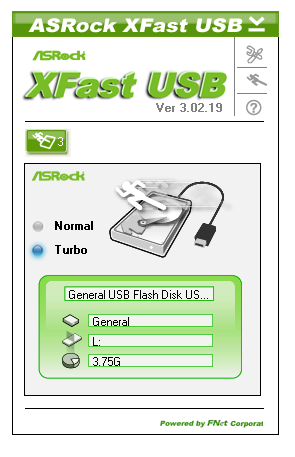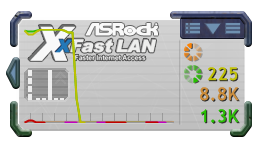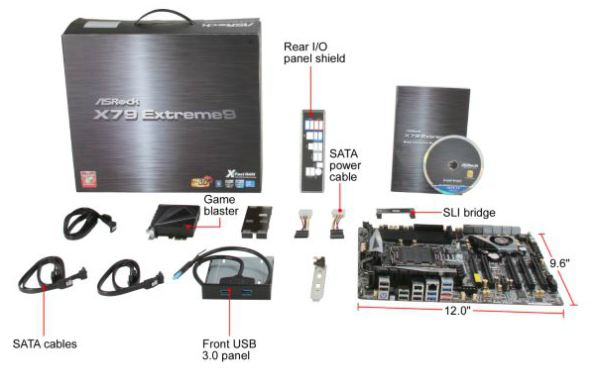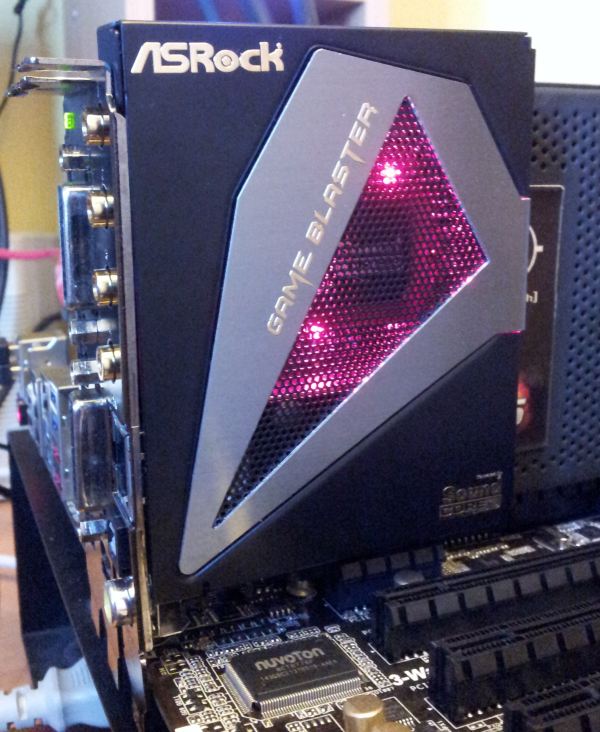ASRock X79 Extreme9 Review - Price For Performance?
by Ian Cutress on January 24, 2012 2:00 AM EST- Posted in
- Motherboards
- ASRock
- X79
In The Box
Software Setup Guide
User Manual / Quick Installation Guide
Driver CD
I/O Shield
USB 3.0 front panel device with SSD holder
6 SATA Cables
2 4-pin Molex-to-SATA power adaptors
2S SLI Bridge
3-way 2S1S SLI Bridge
ASRock Game Blaster
Image from Newegg
The USB 3.0 front panel is the same one we saw back in January 2010 bundled with the ASRock P67 series - a nice addition I've always liked, because it comes with an SSD holder too. With this in the case, there is still one USB 3.0 header free on board for USB 3.0 enabled cases. The Game Blaster is as shown - a PCIe x1 card that lights up red, and contains four audio outputs, as well as a Broadcom NIC and SPDIF outputs.
Board Features
| ASRock X79 Extreme9 | |
| Size | ATX |
| CPU Interface | LGA2011 |
| CPU Support | Intel Second Generation Core i7 Sandy Bridge E |
| Chipset | Intel X79 |
| Base Clock Frequency | 100 MHz |
| Core Voltage | Default, 0.60 V to 1.70 V |
| CPU Clock Multiplier | Auto, 12x to 60x |
| DRAM Voltage | Auto, 1.2 V to 1.8 V |
| DRAM Command Rate | Auto, 1N to 3N |
| Memory Slots |
Eight DDR3 DIMM slots supporting up to 64 GB Up to Quad Channel Support for DDR3, 800-2400 MHz |
| Expansion Slots |
2 x PCIe Gen 3 x16 3 x PCIe Gen 3 x8 1 x PCIe x1 |
| Onboard SATA/RAID |
2 x SATA 6 Gbps, Support for RAID 0, 1, 5, 10 4 x SATA 3 Gbps, Support for RAID 0, 1, 5, 10 2 x SATA 6 Gbps, Marvell SE9220, Support for RAID 0, 1 4 x SATA 6 Gbps, Marvell SE9172, Support for RAID 0, 1 |
| Onboard |
4 x SATA 3 Gbps (PCH) 8 x SATA 6 Gbps (2 PCH, 6 Controller) 6 x Fan Headers 1 x 4-pin Molex CFX/SLI Power Connector 1 x IR Header 1 x Front Panel Header 1 x Front Panel Audio Header 3 x USB 2.0 Headers 2 x USB 3.0 Header 1 x COM Header 1 x Clear CMOS header Power/Reset Buttons + Debug LED 1 x IEEE 1394 header |
| Onboard LAN |
Broadcom BCM5778 on board Broadcom BCM5778 on the Game Blaster Teaming Possible |
| Onboard Audio | Creative Sound Core3D quad-core sound and voice processor |
| Power Connectors |
1 x 24-pin ATX connector 1 x 8-pin 12V connector 1 x 4-pin Molex CFX/SLI Power Connector |
| Fan Headers |
2 x CPU Fan Header (one 4-pin, one 3-pin) 1 x PWR Headers (3-pin) 3 x CHA Headers (one 4-pin, two 3-pin) |
| IO Panel |
1 x Keyboard Port 1 x Clear CMOS Button 6 x USB 2.0 4 x USB 3.0 2 x eSATA 6 Gbps 1 x Gigabit Ethernet |
| BIOS Version | P1.90 |
| Warranty Period | 3 Years |
As mentioned earlier in the review, the extra SATA ports are a good addition. The audio for this board is an upgrade compared to every X79 board we've tested so far, so much so that it is transferred onto the PCIe x1 Game Blaster add-on, with the second Broadcom NIC.
Software
ASRock is going the way of ASUS, in terms of combining almost all their software elements for the board into one package - in this case, we have the ASRock eXtreme Tuning Utility (AXTU), alongside the other licensed software used by ASRock - XFast LAN and XFast USB.
The AXTU software isn't as elegant as ASUS' solution - upon opening the hardware monitor greets you with CPU speeds, temperatures, fan speeds, and voltages. The fan control section is essentially a reworking of the BIOS fan controls without any extra advantages. The overclocking section is interesting, as the CPU Ratio adjust needs to be enabled in the BIOS for a user to apply any changes in the OS. BCLK changes require a reboot, and only the first change per boot is stored in BIOS. The CPU and VCCSA voltages are all offset based - personally I'd prefer absolute values as an option as well. Also included are the OC DNA submenus (for saving fan/OC profiles), Intelligent Energy Saver which attempts to optimize CPU voltage, and XFast RAM. I covered XFast RAM in my last ASRock review - it allows 32-bit users to use the memory space beyond the 3.2 GiB limit imposed by a 32-bit OS, or it allows 64-bit users to use some of their memory as a RAMDisk, and so by moving temporary files over to the RAMDisk it should help speed up the system.

XFast USB is a utility which implements its own USB tool for one plugged in USB device, in order to speed up transfers. In the past, we've seen this increase both peak throughput and general copy times. At some point though, ASRock should allow this to stretch to all the USB ports on a system, rather than just one at a time.

XFast LAN is another tool licensed by ASRock, more commonly known as cFosSpeed which retails at 10 Euros. It allows your internet usage to be monitored and shaped, giving priority to user selected transfers (e.g. video streaming, gaming, VOIP), while other network usage may be occurring (file transfer, downloads).













14 Comments
View All Comments
Hauk - Tuesday, January 24, 2012 - link
I remember jumping to X58 when I saw that a reasonably priced cpu (i7 920) which would OC like crazy came available. Not so much with X79, still waiting for i7 3820, all parts on hand, including an ASRock Extreme 7 ($259). It's not such a bad platform when cheap mobo's, cpus, and DDR3 are available. What about it Intel?? Stupid move IMO not getting 3820 to market sooner. X79 could have garnered more steam than it has..landerf - Tuesday, January 24, 2012 - link
For the record Creative's Core3D doesn't offload openal, in case anyone was expecting it too.BPB - Tuesday, January 24, 2012 - link
Does this board support SRT? If so I would actually consider spending the money on it.Blibbax - Tuesday, January 24, 2012 - link
"The X79 Extreme9 comes in around +50% more than those boards ($360 vs. ~$240), meaning I would expect 50% more when it came to the Extreme9."It never works like this. Is a Ferrari 5000% better than a Ford? What about 3960x vs. 3930k?
If you want maximum performance per price, there's no way you'd be looking at SB-E anyway.
purefun1965 - Wednesday, January 25, 2012 - link
I feel its overpriced. I would like it more if it was $300.00Stas - Wednesday, January 25, 2012 - link
ClrCMOS button is nice. That's about it.Stas - Wednesday, January 25, 2012 - link
Also, no 24-phase power? O.oAlexIsAlex - Wednesday, January 25, 2012 - link
I mentioned this in the last motherboard review, but as I didn't get an answer either way, I'll ask again just in case:What would be nice, in motherboard reviews, would be a measure of the cold boot (POST) time. This is something that different bioses can be differentiated on, and UFEI offers the potential for very fast boots if manufacturers take advantage of it properly.
Would it be possible to report, for comparison, the time between the power button being pressed and the installed bootloader starting? I was thinking it might be easiest to measure this by having no OS on the boot media and measuring the time to the "please insert boot media" message, but I'm sure you can think of other ways of doing it.
Another commenter also requested that this be done for both stock and overclocked settings, as he found boot times to be much slower with overclocked settings on his motherboard.
bji - Wednesday, January 25, 2012 - link
I would absolutely love to see these figures also. It is a major annoyance to me that my ASUS motherboard takes a full 7 - 8 seconds to even show the POST screen, and a further 1 - 2 seconds after that to get to my bootloader. I would personally highly value a greatly reduced POST time and would like to have this information in motherboard reviews. Having these values measured, evaluated, and compared is the only way that motherboard and BIOS makers will have any incentive to improve.javier_machuk - Sunday, January 29, 2012 - link
I'm on the same boat! my asus z68 board takes longer to post than to load windows with a intel 510 ssd!It would be interesting to compare this values between various manufacturers.